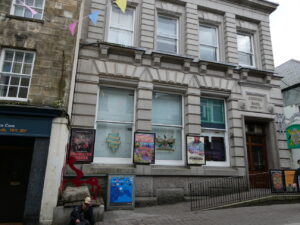Banking in Cornwall Part 3: The early Cornish Bank, 1771-1830
Categories Commerce & Industry1 CommentIn part 2, John Dirring related how regular institutionalized banking in Cornwall began with the Miners’ Bank in Truro in 1771. He now continues with the story of the Cornish Bank, established very soon afterwards. Prominent in its earlier years was Francis Basset of Tehidy (Lord de Dunstanville), whose monument on Carn Brea (seen here) overlooks Cornwall’s central mining district.
 Bassett Monument
Bassett Monument
It was seen previously that the first Miners’ Bank partnership of January 1771 did not last very long. The more robust agreement which followed in September of that year created a business tailored to suit the financial needs of mining investors (`adventurers’), who were shouldering the risks of an uncertain and speculative industry. The partners in the Miners’ Bank (who were adventurers themselves, or involved in the associated metal trades) were well aware of the inherent dangers confronting their new institution; and that under unlimited liability, everything that they owned was at stake if the venture ran into difficulties, and a rush of withdrawals and cashing-in of their banknotes outran the immediately available assets.
A more broadly-based institution, which did not depend on the fortunes of mining, was desirable for many potential depositors and investing partners; one able to dependably serve a much wider range of interests. Banks as purely financial institutions (rather than as adjuncts to other businesses) had been familiar in London for decades; but they were as yet unproven in Cornwall, and the long-established landed families who controlled much of the wealth and economic prospects were cautious about becoming involved in banking. Their fortunes depended on the steady incomes from rentals which supported their extensive estates and political power, and there was little inclination to risk everything in the unlimited liability of uncertain businesses. Nevertheless, some of them were involved with mining – but as `mineral lords’, owning the rights to ore deposits where they existed under their land, and letting the `setts’ (as the specified working areas were called) to mine promoters in return for a proportion of the ore sales – without incurring any liability to their estates. However, possessing the capital to ensure the success of a suitable financial venture, some were willing to enter into banking – if the risk was spread over a wide range of loans and investments, and not narrowly-based on a single sector of activity like mining, however prosperous its present appearance and prospects may have seemed.
So the Cornish Bank of Sir John Molesworth & Co began business in Boscawen Street, Truro on 24th June 1771, with the capital supplied at first by prominent landowners with no direct investment in mining. There were four partners: Sir John himself, the fifth baronet of that name, of Pencarrow near Bodmin (1729-1775); Edward Craggs Eliot, of St Germans (1727-1804); Silvanus Jenkins of Truro (d. 1804); and Humphry Mackworth Praed, of Trevethoe, St Ives (c.1718-1803).
 The former Cornish Bank building in Church Street, Falmouth, still displays the bank’s foundation date [John Dirring]
The former Cornish Bank building in Church Street, Falmouth, still displays the bank’s foundation date [John Dirring]
According to John Rowe, in his Cornwall in the Age of the Industrial Revolution, both Molesworth and Eliot saw banking as a means of providing supplementary income to their estate rentals. They were both based in east Cornwall; where, apart from agriculture, there were few local opportunities for investment to enhance their estates: the development of mining and industrial enterprise around Caradon and in the Clay Country still lay largely in the future. Both had long-running Parliamentary careers; indeed their families had been prominent in politics for centuries: Eliot’s ancestor, Sir John Eliot, had been imprisoned by Charles I for his outspoken political views. After Molesworth’s death in 1775, the bank partnership became known as `Eliot & Praed’.
Silvanus Jenkins, resident in Truro (and serving as mayor in 1784), was the managing partner in the early years of the Cornish Bank, up to his sudden death in 1804. Boase (in the banking section of his Collectanea Cornubiensia) tells us that Silvanus’ brother David (d. 1791) joined the bank around 1776, together with Thomas Nankiwell (d. 1817). David Jenkins was involved with Willyams of the Miners’ Bank in Swansea copper smelting. To be an investor in smelting was much safer than being a mining adventurer, as the smelters determined the price of the ore through the `ticketing’ system by which it was traded, and were able to draw on supplies worldwide.
 Francis Basset on his Grand Tour in Italy. Oil on canvas by Pompeo Batoni, 1778 [picryl.com]
Francis Basset on his Grand Tour in Italy. Oil on canvas by Pompeo Batoni, 1778 [picryl.com]
Francis Basset of Tehidy (1757-1835), too young for banking in 1771, became a partner in 1779, continuing until 1801. The Basset family had been at Tehidy in Illogan since the twelfth century; with a long prominence in Cornish society and politics. After Harrow and Eton, he had continued his education at Cambridge, rounding it out with the customary Grand Tour of Europe; and had been created a baronet in 1779, the year he joined the bank. This was in recognition of his initiative in leading a group of miners to help in the emergency strengthening of the defences of Plymouth – war and international conflict were a recurrent background to life in eighteenth-century Britain. The development of mining on the extensive Basset estates around Camborne, Redruth and Illogan had been actively nurtured in the earlier eighteenth century by an increasing direct investment in mining shares, which was gradually reduced as profitability declined. Although reluctant to invest, there was a deeper-seated interest among the gentry in maintaining the mining industry, which amounted to a social responsibility as it was the main source of employment, prosperity and stability; and both the Bassets and the Praeds, as large-scale mineral lords, were willing to invest to secure the long-term future of profitable mines. Basset took a leading part in promoting the interests of the Cornish copper industry generally, recognised after his death in the erection of the Carn Brea monument.
William Praed (1749-1833), the son of Humphry, had also joined the Cornish Bank in 1779; but his more extensive interests lay elsewhere, and he did not live in Cornwall – although he was MP for St Ives from 1781 to 1806. In 1778, he had married Elizabeth Tyringham, and they lived at Tyringham Hall in Buckinghamshire, near Newport Pagnell (or, as would be said nowadays, near Milton Keynes). Through his marriage, he became part-owner of two estates in Jamaica, with enslaved people, until 1817; and in Parliament he opposed the abolition of slavery. He was active in London banking; and with Eliot became partners with Biddulph and Cocks, established since about 1750, who were the first London agents of the Cornish Bank. They may even have had a hand in setting it up. Such assistance was sometimes provided by London bankers, as it created business opportunities. Banking historian Leslie Pressnell calls it `midwifery from the capital’. Be that as it may, Eliot and Praed left them in 1793; and in 1800 set up their own London institution, Praed & Co in Fleet Street, acting as agent for the Cornish Bank. This arrangement can be seen as a West End counterpart of the connection between the Miners’ Bank and Lemon, Buller, Furly and Lubbock’s institution in the City. This is not to say that this essentially commercial relationship was without its difficulties and disadvantages; the Cornish Bank also used Glyn, Mills & Co in the City, mostly for arranging investments in Government securities.
It is worth mentioning here, for the sake of clarity, that there was another similar relationship between the Exeter Bank and the London firm of Halliday, Duntze, Praed & Co in Cornhill. This Praed was William Mackworth Praed, a lawyer and cousin of William Praed, and sometimes confused with him. William Mackworth Praed’s father was Humphry’s brother, and had been a founding partner of the Exeter Bank with John Duntze in 1769.
By 1802, the partnership of Praed & Co in Fleet Street had been enlarged, and now included Philip Box, a banker from Buckingham who was also an associate of Praed’s in the Grand Junction Canal, of which Praed was chairman from 1793 to 1821. This important canal, from London to Birmingham, was his major concern; the depth of his involvement is described by Faulkner in his history of the undertaking, and is commemorated in Praed Street, Paddington, where the canal’s London basin is situated.
 The Grand Junction (later Grand Union) Canal near Paddington in 2024 [Garry Tregidga]
The Grand Junction (later Grand Union) Canal near Paddington in 2024 [Garry Tregidga]
William Praed became the senior partner in the Cornish Bank in 1802, and would have brought a wealth of managerial expertise and banking experience to the firm. This however may have been more in a consultative capacity than as an active manager, as he remained domiciled in Tyringham Hall and continued to be preoccupied elsewhere. Indeed he resigned his Parliamentary seat in 1806 to be better able to focus his attention on the London bank.
William Tweedy (1766-1854), who had been a clerk in the Navy Office in London, moved to Cornwall to become a partner in 1802, and took on the management of the bank in 1804 after Silvanus Jenkins’ death. The Tweedy family were Quakers; and financial administrators first and foremost, with no major outside business involvements to distract their attention away from the bank.
The mining interest was more forcefully represented when John Williams (1777-1849, son of `Old John’, the `King of Gwennap’) became a partner in the Cornish Bank in 1810. Maybe it was the strength of his ruthless personality that gained him a £10,000 overdraft when the other partners were restricted to £1,000; but the bank also benefited from the profits of his enterprises. This overdraft however, as Pressnell tells us, was on condition that the accommodation was temporary and not ongoing. The Williams family were dominant in Cornish mining, but were upwardly-mobile and broadening their economic base; they were offering secure and attractive opportunities for investment. Like the Vivians at the Miners’ Bank, they were also involved in smelting in Abertawe (Swansea); to the extent that John’s brother Michael Williams (1785-1858), who became a partner in the Cornish Bank in 1817, served as High Sheriff of Glamorgan in 1840.
From its inception, the bank had steadily pursued a cautious financial strategy, while at the same time making the most of the opportunities. Liam Brunt, in an article in the Journal of Economic History in 2006, however regards it as more the equivalent of a modern-day venture capital provider, in that it was willing to advance large sums for the erection of bespoke mine pumping engines; indeed, Boulton & Watt became substantial customers. As John Rowe relates, the copper trade was very unfavourable to Cornwall in the 1770s, being dominated by the cheaper product from the opencast mining on Ynys Môn (Anglesey). Watt’s engines, being more efficient, could substantially reduce the pumping costs of a mine, thereby making it more competitive and improving its chances of survival. As the bank partners were keen to keep the Cornish mining industry in being for the sake of economic and social stability, they were ready to assist Boulton & Watt by helping to finance their engines. Boulton, however, was keenly aware that there were sharp limits to the bank’s advances, finding them to be `remarkably cautious’. This cautious lending policy of the bank is discussed in detail by Pressnell in his Country Banking in the Industrial Revolution (1956), drawing on a rich resource which has since disappeared – the Order (or Minute) Book of the Cornish Bank beginning in 1774.
In the bank’s earliest years, lending was very much the prerogative of the individual partners, depending on their social and business connections as much as their commercial judgment. They were mindful of the fact that they were working with their own and their colleagues’ and depositors’ money, which could be very limited in respect of the demands of prospective borrowers, and the ongoing cumulative risk of existing loans. When times were harder and money scarce, fewer new loans were taken on, and more security was demanded from the borrower. In extreme conditions, only a few well-established clients would be favoured with advances; and the bank would recall existing loans, especially if troubling signs of the borrower’s possible insolvency were becoming apparent.
In 1779, the year that Francis Basset had led his miners to Plymouth, the American war was entering its final phase after France and Spain had joined the conflict. Money became scarcer than usual as people kept their currency at home and lived on credit. The Cornish Bank restricted its advances, and took every opportunity or pretext to call in existing loans as defaults became more common. Nine substantial debts were identified for repayment in November 1779, some to the point of pressing legal action. This however had little immediate effect; the amounts were still outstanding, with accumulating interest arrears, several years later. Credit was traditionally regarded as long term, and embedded as such in the culture. Overdrafts in particular could easily become perpetual unless carefully managed. By the end of 1782, a general restriction was in place, except for seven favoured clients – and they could only overdraw up to a maximum of £9,000 between them. This would have been relaxed as better times returned; but the onset of the French wars brought a new crisis in 1793. And so it went on, as the long years of conflict which followed brought new opportunities and new risks. Only a strict and prudent lending policy would lead to survival and prosperity.
As was common in early private banks, the partners also tended to avail themselves of overdraft facilities without limit. Molesworth himself had been heavily overdrawn; his indebtedness was still being resolved ten years after his death, and part of it had to be written off. Humphry Mackworth Praed owed the bank £10,000 by 1802 – an enormous liability in relation to the available capital. The copper firm of Jenkins, Willyams & Co, in which David Jenkins was a partner, was granted an overdraft of £4,000 in 1792, and seems to have overdrawn as a matter of routine. Indeed, it was particularly favoured; no interest was charged, by a resolution of the bank partners in 1803.
In 1812, partners’ borrowings were generally limited to £1,000 unless otherwise agreed (as they were with John Williams). This was only bringing them into line with the much stricter lending policy that had been applied to clients generally almost from the beginning, which was designed to keep risky but highly remunerative investments within safe limits. In 1774, the bank’s managing clerks in Boscawen Street, Jenkins and Porter (who both lived on the premises) were authorized to lend up to £200 (with some discretion up to £500); but amounts over this had to be approved by all the partners; only in 1813 was this £200 limit raised to £3,000. Unlike their counterparts at the Miners’ Bank, Jenkins and Porter do not appear to have quite achieved the status of `confidential clerks’, and did not become partners. It is not known at present whether Jenkins was related to David and Silvanus.
The Cornish Copper Company of Hayle – smelters and metal manufacturers – was also particularly favoured. It was at the head of the list of just nine authorized borrowers in 1781, and allowed to borrow up to £3,000 at a time of otherwise total credit restraint. Twenty years later, its credit was being further extended, but not by the amount being asked for.
Involvement with individuals and organizations in the mining industry was inescapable, however broadly-based the bank hoped to become; and became deeper and more intimate as the prosperity of the mines recovered. A Mr Nicholas, involved in Cook’s Kitchen mine in Illogan, owed at least £1,700 by October 1795. Lord de Dunstanville, its mineral lord, became further committed to this mine as an adventurer, owning a 1/8 share in 1799. Later, in the nineteenth century, it would become one of the largest and deepest mining operations in Cornwall; successful, but still variable in its fortunes. Long-term and successful financial commitments by the bank’s partners in their own right would, no doubt, inform the bank’s own lending decisions. Mines would also be favoured if they were competently managed. The renowned captain of Cook’s Kitchen at this time was Richard Trevithick’s father.
After over twenty years of war and the final defeat of Napoleon in 1815, the level of overdrafts was causing serious concern at Praed & Co in London, where the Cornish Bank’s account was in an unsatisfactory state. The war economy was not given a smooth transition into a hoped-for peacetime prosperity. Soldiers and sailors were quickly demobilized, many with little prospect of employment; and military supplies were no longer needed. The marginal land (such as that around Bodmin Moor) which had been brought into cultivation was no longer profitable as food prices collapsed. Everyone wanted to borrow money; and even requests from familiar and favoured clients were to be subject to intense scrutiny, while as many existing loans as possible were to be called in. Prompt repayment when asked for was a condition imposed on new lending; and securities offered, which were to be professionally vetted, had to be immediately realisable. Properties, and mortgages on property, were not acceptable as collateral. Additionally, there were to be no loans under £100. Pressnell suggests that this may have been to avoid the trouble and expense of recovery from defaulters, or because £100 was the minimum claim allowed in bankruptcy cases. Such a policy would have seemed harsh, compared with what had gone before; but these were tough times in a hard and ruthless age, and enabled the bank to survive where others failed or ceased trading.
As better but still precarious times returned, some exceptions were made. Advances could be made against reputable bills of exchange which could be easily passed on; Government stock was acceptable as security if it was assigned to one or other of the bank’s partners; loans could be granted if refusal would cause offence and there was little risk; and those who, like John Williams, were already specially favoured were unaffected.
Prosperity did return in the early 1820s, with trade encouraged by reductions in excise duties. Credit became easier, but speculation was rife, leading to the major financial crisis of 1825. The Mevagissey Bank was caught out in its speculative expansion in St Austell, failing with dire consequences for the community in which it operated. Traders in Truro found it necessary to publish a statement affirming their confidence in the Truro banks, and that their notes would still be accepted.
There had been much mining speculation in Cornwall. As Rowe relates, some was genuine and fruitful, some deceptive and fraudulent. There was much more of it in Central and South America, beginning the competition which would soon undermine Cornish mining prosperity. The age of joint-stock capitalism was also just beginning, facilitated in 1825 by the repeal of the so-called Bubble Act of 1720 (which in its day had been the reaction against the fraudulent schemes of the time). One of the very first promotions was the Devonshire and Cornwall Mining Association. Promoted in London, the intention was to acquire the rights to work twelve existing mines, thus spreading the risk for the small investor, and attracting a much broader capital base than was available to a single mine worked in the traditional cost-book manner by a few local adventurers. Two London banks and two Cornish banks (Carne’s Penzance Bank and the Cornish Bank) acted as treasurers; William Carne became a director, as indeed did Lord Palmerston. This enterprise might have succeeded, if the mines involved had real prospects – but many of them did not, and the scheme had been oversold to the directors and investors, largely by the glowing reports of Captain Thomas Teague and others. Teague had borrowed large sums from the Cornish Bank, which in 1827 had to foreclose when he failed to repay £3,000 or £4,000 as promised. Yet, despite all this and more, he was highly-regarded in Cornwall; thousands turned out to his funeral in Redruth in 1839.
Away from the copper industry, involvement in maritime ventures could be financially remunerative; but was especially risky for bankers, as it would commit their capital against assets which, like mortgages on property, were not immediately realizable in times of need – and which moreover would be at sea in the more uncertain days of sail. However, partners in the Cornish Bank who were individually willing to take the risks – and had the expertise or acumen – set up a separate partnership that would not prejudice the main business. The Cornish Naval Bank was begun in Church Street, Falmouth in 1806 as Praed, Rogers & Co; although in later years it turned away from the sea to become an ordinary branch of the bank. John Rogers (1750-1832) was Francis Basset’s brother-in-law.
In 1830, the Cornish Bank partnership had become Tweedy, Williams & Co, whose subsequent fortunes will be the subject of a later part in this series. It was natural for the Williams family to become more fully involved with banking, as many of the transactions from their office at Scorrier House were of a financial nature. In the early years of the nineteenth century, they were addressing the chronic currency shortage (particularly of small change) by issuing their own trade tokens. The `Cornish Penny’ was one of many such local tokens in use throughout Britain at the time. Issued in miners’ wages, it was accepted throughout the central mining district, and was redeemable in £1 lots at Scorrier House. The currency shortage was deep-rooted and had many causes, but essentially not enough coin had been minted by the Government over the previous century.
Assisting in the management of the scarce coin of the realm was an ordinary function of local institutions like the Cornish Bank, alongside the issuing of their own bank notes. Apart from distributing newly-minted coin, they were also involved in collecting old and worn-out money and sending it in via their London correspondents, as well as the foreign coins which were in wide circulation from necessity.
Bank of England notes were in circulation in Cornwall to some extent, but were unfamiliar and not always accepted; they were not yet legal tender, and only payable in London. In 1802 the Cornish Bank issued more of its own widely-accepted £1 notes (which could be exchanged for gold on demand in Truro), along with a new issue of £5 notes only payable at its London agents. This was a common ploy of country banks, as it avoided the chance of them being cashed in locally and maybe starting a run on the bank, with everyone demanding payment at once; but it relied on the bank’s standing in the community if such notes were to be acceptable in everyday transactions. For the bank, this risk of a run was less with the £1 notes; but there were far more of them in circulation, and many more people would be affected should the bank fail and the notes suddenly become worthless. There was a need for the bank to maintain an adequate liquid fund at all times to cover such eventualities; but it was always tempting to make this less of a priority when times were good, and to issue more and more notes to meet public demand. Reputable banks could reduce this cover, as their notes would stay out in circulation almost in perpetuity; but precautionary measures had to be taken in good time. In 1815, the Cornish Bank backed up their issue by acquiring more Government securities (which could be realized on demand) – and the calling in of loans and overdrafts was to help pay for this.
In conclusion, then, it is seen that successful local banking two centuries ago depended on a careful balancing of the varied and interdependent aspects of the business – attracting deposits, assessing loan applications, forecasting business prospects, being bold yet cautious in taking risks, and above all in maintaining and enhancing the bank’s reputation for financial integrity. Pressnell takes the Cornish Bank as an exemplar of good practice; yet times changed, and in succeeding generations once-reputable institutions could fail.
In a later part in this series, it will be seen that misfortune did indeed befall the Cornish Bank in 1879. In the next instalment, however, attention will turn to what may be termed `maritime banking’ in the ports of Cornwall.
References and further reading
D.B. Barton, Essays in Cornish Mining History: Volume Two (1971)
G.C. Boase, Collectanea Cornubiensia (1890)
- Brunt, `Rediscovering risk: country banks as venture capital firms in the First Industrial Revolution’, Journal of Economic History 66/1 (2006)
A.H. Faulkner, The Grand J unction Canal (1972)
A.E. Feavearyear, The Pound Sterling (second edition, 1963)
L.S. Pressnell, Country Banking in the Industrial Revolution (1956)
- Rowe, Cornwall in the Age of the Industrial Revolution (second edition, 1993)
- Tangye, Tehidy and the Bassets: the rise and fall of a great Cornish family (2002)
- Taylor, Creating Capitalism: Joint Stock Enterprise in British Politics and Culture, 1800-1870 (2006)

John Dirring comes from a farming background, and worked in the building and construction industry after graduating in economics from Lanchester Polytechnic (now Coventry University) in 1974. He returned to academic life in 1996 via adult education courses in astronomy and geology, before embarking on a Historical Studies BA at Exeter. From there, he went on to complete an MA and PhD at the Institute of Cornish Studies.
He continues with his study and researches in banking history; and is also very interested in the social aspects of money and credit, and the opportunities and challenges facing the new kinds of financial institution that are now becoming established in Cornwall and around the world.

Great story-telling again John. Amazing to see how interwoven and mutually dependent mining, manufacturing and banking were at that time and how so much was ‘made’ in Cornwall.